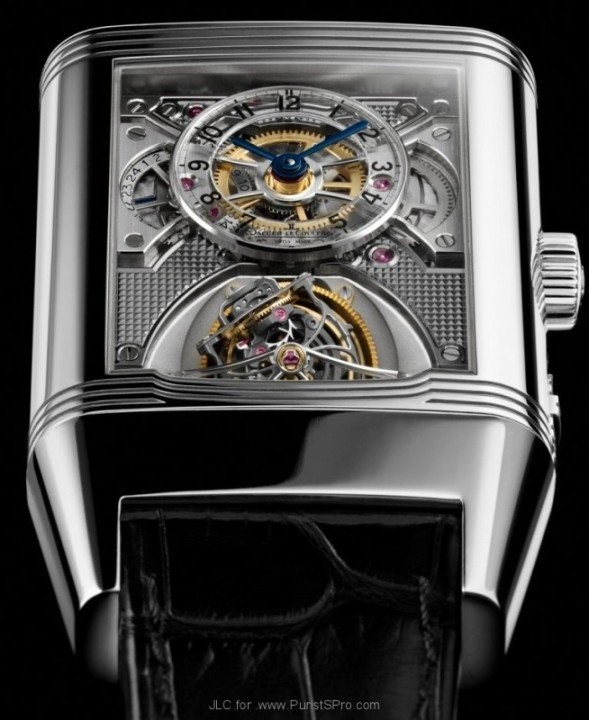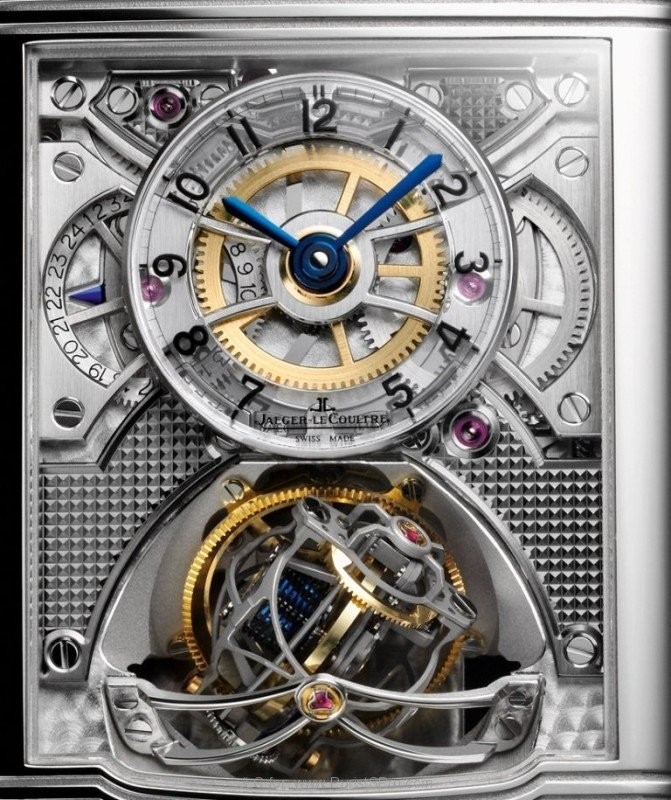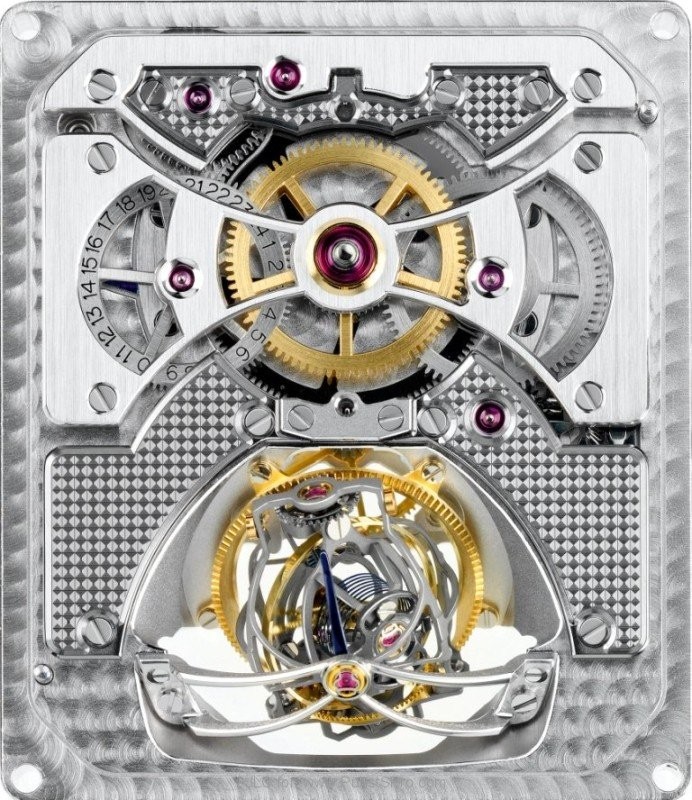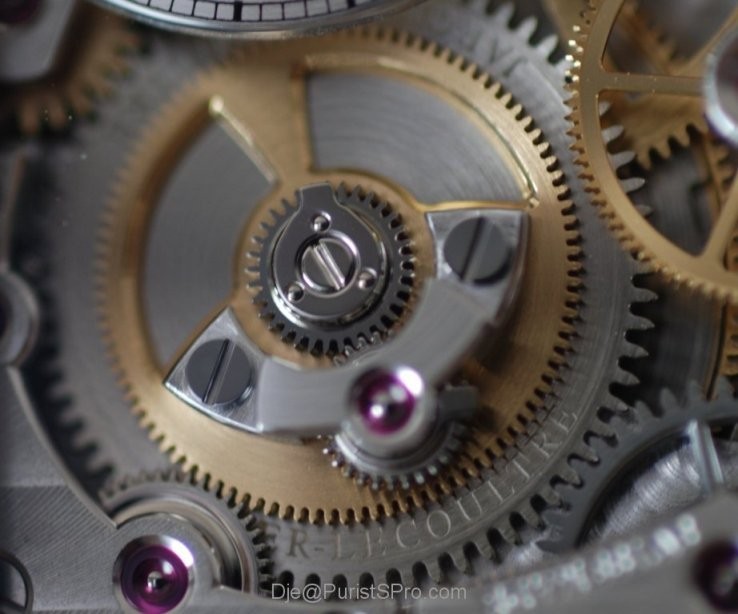
Dje
7785

Jaeger-LeCoultre Gyrotourbillon 2: A fascinating chronometric Reverso!
So here is
finally coming the first and perhaps the most fascinating new watch from
Jaeger-LeCoultre this year?
1833-2008,
that's 175 years of history to celebrate so the task is huge 
The launch of
the Gyrotourbillon 1 a
few years back in 2004 was a great time in Jaeger-LeCoultre's history.
The Gyrotourbillon was indeed an instant revelation of the innovative potential
of the "Grande maison". The following years saw the birth of
several great watches like the Master Minute Repeater, the Grande Complication
a Triptyque, the Amvox2, The Duometre a Chronographe, the Master Tourbillon,
the Master Compressor Extreme Lab on the complication side, but also the
Squadra range, the Diving range or the expansion of the Reverso 8 Days range.

It would be far
from seeing the truth to consider this Gyrotourbillon 2 as a Reverso cased
Gyrotourbillon 1! In fact this watch nearly only keeps the Gyrotourbillon
principle, here applied with several innovations in a new calibre.

The first and
main difference with the Gyrotourbillon 1, and also in my opinion the most
appealing new characteristic of this calibre 174 is its cylindrical balance
spring with end curves. This kind of balance spring is totally new in wrist
watches even if John Arnold patented this kind of helical spiral in 1882 (some references
also date this patent to 1776) and if it was even apparently invented much earlier by Robert Hooke.
Such cylindrical (or helical) spring supposedly improves chronometry as it is easier to make it isochronous.

So far only
marine chronometers and a few pocket watches have been equipped with such
balance spring. The reasons were that it is complex to manufacture and
particularly to miniaturize. In fact its geometry goes well with the form of
the Gyrotourbillon whose tourbillon cage has the necessary third dimension to
house this voluminous balance spring.

The
Gyrotourbillon combines two intertwined tourbillon cages, the first inner cage
doing one rotation in 18.75 seconds and the second outer cage in 1 minute. This
combination on 2 axes set at a 90° angle creates the ellipsoidal movement of
the regulator that is said to isolate this very regulator from the
gravitational effects on the rate in any position. While the Gyrotourbillon 1
needed 2 minutes to take all positions, this Gyrotourbillon 2 will need 5
minutes.

Once again
everything has been done to ensure the best timing to this calibre. The large
size 14 carat gold balance wheel regulated to 4htz, or 28800 vph, has a 12.5
mgXcm² and is adjusted through gold inertia blocks arranged around its rim.

The cylindrical
balance spring has a rectangular section.

The two final
curves are chosen to allow a perfect breathing and a consequent isochronism. I
have not been able to know the name of these curbs. Jaeger-LeCoultre has used
existing curbs, but not Phillips curbs. The spring is pinned in a traditional
triangular stud and the stud holder is secured with two screws for a safe fix.

The difference
of geometry between the two Gyrotourbillon is particularly obvious if you
compare these two drawings. It also shows that consequently the cage is not
exactly the same.

Looking at
these cages below it looks like a torture cage for the balance wheel but it is
apparently a magical treat to forget gravity!

The new balance
Wheel has open-worked arms to decrease the overall moving weight inside the
cage. The 100 or so parts of the Gyrotourbillon apparel weight 3.4 grams (while the full
calibre is 371 parts). The full spherical diameter of the aluminium cage is 10.85 mm.

The dial side
shows the hours and minutes through two heat blued hands on a sapphire dial at
12, and a close wheel on the left upper part of the dial shows the 24 hours.
This is not a second time zone.

The back side
shows the power reserve indicator of 50 hours.

The watch has
simple functions but once again that's the basic functioning that is
improved.

The mainspring is
fitted on top with a torque limitation device that limits the power reserve to
50 hours and that ensures that the watch is stopped before becoming un-precise.
In fact I'm tempted to consider also this torque limitation device,
coupled with the power reserve indicator like a torque indicator. As long as
you make sure that the power reserve is between the two extremes you have a
torque considered as optimal, or at least sufficient. Or in more pragmatic
terms, with this device as long as the watch is running it has the desired
torque!

The torque
imitation device is quite nice and simple in principle. The principle is about
two wheels turning together. One is concentric with the barrel, the other one
is below the little bridge. They don't have the same number of teeth.
One is driving
when the barrel is giving power to the main train, the other one is driving
when the barrel is being wound. The driving one drives the other, in one
direction or the other. Both have each a unique upper tooth and these two teeth
can't cross. When they touch the device is stopped, either stopping the
winding or the main train.
There's a
patent applied for this device.

The power
reserve indicator also has a little refinement. There's an additional
hairspring to compensate the play in the gear train, so that the power reserve
indicated is always the real power reserve in the main spring.

The main spring
is covered on top and below with sapphire parts to reduce friction.

The winding
system is equipped with conic wheels.

The
cannon-pinion wheel has a new and surprising design.
The
cannon-pinion wheel is used to engage the main train to the cannon-pinion, i.e.
to the hands. When the watch is running the wheel is attached to the
cannon-pinion through sufficient friction. When the hands are set through the
crown the friction between the cannon-pinion wheel and the cannon-pinion is not
enough to make the main train be driven by the cannon-pinion. In some way the
cannon-pinion is by force disengaged from the main train when the hands are
set.

In the case of the
Gyrotourbillon 2 the cannon-pinion wheel is slightly flexible and is not round
when it is not engaged. This wheel has 5 arms, one being detached from the
others.
When the
cannon-pinion is engaged in the wheel the wheel takes its round shape and the
movable fifth arm applies a force to the cannon-pinion so that the necessary
friction is distributed all around the cannon-pinion.

There's
also a patent applied on this new wheel design.

Obviously this
amazing watch is not just a chronometric machine. It is somewhat a simple watch
with little additional complication 

Still it is a
very beautiful watch, with a pure horological design, and also a very high
level of finish not seen before on a Jaeger-LeCoultre wrist watch.

The launch of
the Gyrotourbillon in 2004, and several following upscale models, have
necessitated the creation of a new finish department at the manufacture.

The « haut
de gamme » finish department is in some way the legacy of the work done
for years by master watchmakers like Sylvain Golay and his colleagues.

The evaluation
of the finish on this watch will necessitate an open approach to the new
dimension broad by the Gyrotourbillon. This calibre is not just a pile of
assembled pieces like every classical calibre is. The tri-dimensional
Gyrotourbillon adopts a more modern approach than the more classical dial area
finish.

You will please
not forget that the watch shown is an early prototype and doesn't
necessarily show the final finish.

The finish
works is hand made but the hand is sometimes helped by motorized tools.

The tools can
be very traditional like the polish tools in box wood or leather. The materials
offer a very soft polish on some very small and sometimes light pieces.

The intangible
dial and the large opening of the tourbillon cage show a complete view on the
calibre parts. These parts are the style of the watch through their finish.
That's why I wrote pure horological design.

Re-entrant
angles are everywhere, for the pleasure of the high finish fans !

The finish is
sharp and not rounded like it is often the case with Jaeger-LeCoultre. This is
really the work of this new finish department and they even admit that they
keep improving. Some coming Master Tourbillon watches may hopefully get the
next step of finish to be at the top!

Frederick Henry
Royce the co-founder of Rolls-Royce stated that "the perfection is no
small thing but is made of small things". This watch is definitely a new
step towards perfection for Jaeger-LeCoultre.

Some bridges on
the dial side are nailed, a first time for Jaeger-LeCoultre and a very pleasant
result.

The nails
reinforce the visual effect of the sharp angles.

The nickel
silver bridges are also very nicely angled. The angles are polished to bring a
third dimension to the pieces.

So the watch is
technically superb, shows an un-seen level of finish from Jaeger-LeCoultre, but
is it a usable watch?

Let me be
clear ! This is a usable watch. It is made for use. It is simple, precise,
waterproof (30m), comfortable to wear with its integrated leather strap.

This watch
becomes perfect only on the wrist where it is supposed to be the time organ of
your body!

Of course the
Reverso Gyrotourbillon 2 is not an ultra thin. It is a thick watch. But it is
not over thick, neither over large.

This watch was
very cleverly designed as its Reverso case is much more wearable than the
Grande Complication a Triptyque.

In fact the
reversing case is 14.5mm thick. The case and sapphire glasses have a standard
Reverso appearance.

Due to the
weight of the platinum reversible case the watch is fitted with a locking
device like the Grande Complication a Triptyque.

The series will
be strictly limited to 75 pieces in platinum.

This amazing
watch is certainly a satisfying tribute to the long history of the Grande
Maison, from the pioneering spirit of the founder Antoine LeCoultre who
invented the tools that allowed the production of more precise watches to the
following integration in a complete manufacture.

This rare watch
may not be essential for many of the more than 1200 people working at
Jaeger-LeCoultre (around 20% of the total of the Vallee de Joux workers), it
will be an essential watch dream for many of us watch admirers and specially
for the chronometry amateurs.

As this
Gyrotourbillon 2 will be more affordable than the first Gyrotourbillon I have
little doubt that it will encounter an even larger success.

Around 2 thirds
of the 75 Gyrotourbillon 1 have been delivered so far, but the production of
the Gyrotourbillon 2 has already begun.

Now it's
time to decide already if you want it!

This watch will
make a hit at this year's SIHH.

Congratulations
to Jaeger-LeCoultre for this outstanding timepiece.
Here is my all time favourite JLC!
Dje
ps : my sincere thanks to the
Jaeger-LeCoultre teams who gave me some of their precious time while preparing
the soon to be SIHH 2008.
This message has been edited by Dje on 2008-03-29 23:43:31



























